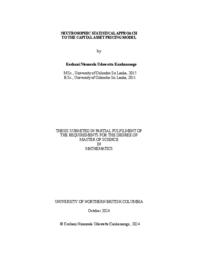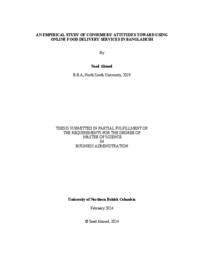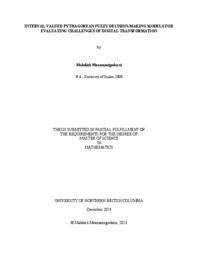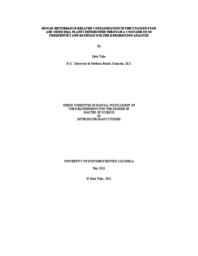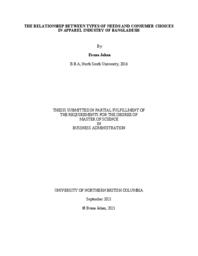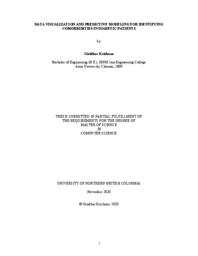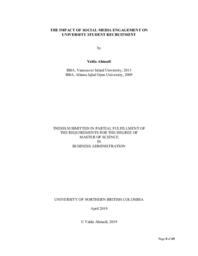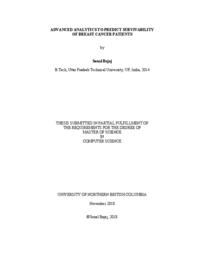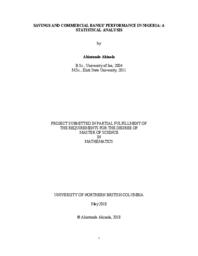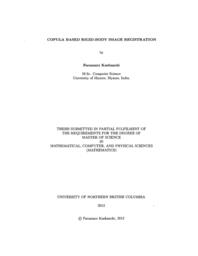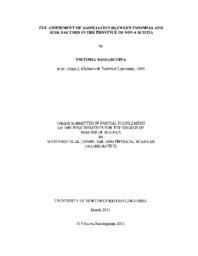Kumar, Pranesh
Person Preferred Name
Pranesh Kumar
Related Works
Content type
Digital Document
Origin Information
Content type
Digital Document
Origin Information
Content type
Digital Document
Description / Synopsis
Archaeological Predictive modelling is a tool that predicts the location of archaeological sites and materials in a region, based on the observed pattern in a sample data or on assumptions about human behavior. This project examines the combination of variables to produce a model with high predictability and the application of inductive predictive modelling method in locating areas of high archaeological potential in Prince George using Binary Logistic Regression. Results from the analysis have shown that terrain variables: slope, ruggedness, elevation, solar incidence and proximity to water, jointly explains the predictive model and that the model successfully predicts areas of high and low potentials in Prince George municipal. The results from the Kvamme’s gain statistic shows that the predictive model is moderately efficient. The study recommends that by incorporating more terrain variables, the model performance will be higher and probably be more efficient.
Origin Information
Content type
Digital Document
Description / Synopsis
The online food delivery service industry has the potential to be one of the biggest industries in Bangladesh and contribute significantly to the economy. Technological advancement has powered the potential expansion of online food delivery services in Bangladesh. While there has been some recent research on the shift in Bangladeshi consumers' food consumption habits, there still needs to be more research on the online food delivery service industry. Noticeably, online food delivery services are only available to people living in large cities or suburban areas in Bangladesh. Rural populations have limited access to these services. The reputation of the delivery services is sometimes adversely affected by inconsistent customer service, which includes problems with order accuracy, poor user interface, and lack of responsiveness. Therefore, this study analyzes the consumers' attitudes toward using online food delivery services in Bangladesh. This study revisited the theory of the technology acceptance model (TAM) theory by retaining user motivation. According to the TAM theory, user motivation is considered as perceived ease of use and perceived usefulness, whereas in this study, perceived usefulness has been simplified by two independent variables: various food choices and time-saving orientation. Thus, the three original constructs from the TAM theory included in this study are attitudes toward using the technology, perceived ease of use, and perceived usefulness. The core objective of the study is to determine the influence of perceived ease of use, various food choices, and time-saving orientation on the consumers' attitudes toward using online food delivery services in Bangladesh. Secondly, the study examines the moderating role of the 'online shopping experience' on the user's motivation in Bangladesh.
Origin Information
Content type
Digital Document
Description / Synopsis
The aim and objective of the thesis entitled “Interval-valued Pythagorean Fuzzy Decision-Making Models for Evaluating Challenges of Digital Transformation” are as follows: The first objective is to develop new entropy and divergence measures to handle the uncertainty under interval-valued Pythagorean fuzzy environment to determine the significance degree/weight DT challenges of the manufacturing systems. The second objective is to develop a hybrid decision-making models to evaluate the DT challenges of the manufacturing systems from interval-valued Pythagorean fuzzy perspective. And the last objective is to propose a comprehensive framework to evaluate digital transformation challenges in sustainable financial service systems of the banking sector.
Origin Information
Content type
Digital Document
Description / Synopsis
Increased development in forestry, oil and gas, road infrastructure, and agriculture sectors across the Swan River Watershed (Alberta, Canada) has led to an increase in the impact they have on the riparian and aquatic ecosystems. These industries require the removal of vegetation for construction and operation, and some do not require buffer zones around waterbodies to protect aquatic habitat. These industries also use herbicides and fertilizers that may contain high levels of heavy metals, as well as glyphosate. In this thesis, I examined the changes to abundance of plant species chosen by Knowledge Keepers of the Swan River First Nation, as well as general plant categories (i.e., shrub, trees, and herbaceous), in relation to industrial development. I also examined how heavy metal and glyphosate content changed in these plant species with distance from industrial development. Sixty-seven sites were sampled across the Swan River Watershed, each with seven transects examining plant abundance. Tissue samples of chosen species were collected on the first, fourth, and seventh transects. I found significant ( = 0.05) changes to the abundance of aquatic and riparian plant species and categories in association with industrial activity. I also found significant ( = 0.05) changes to heavy metal concentrations in response to industrial presence and distance. There was a significant ( = 0.05) increase in the presence of glyphosate in plant species when forestry or agriculture were present at a site. These results were obtained after conducting a comparison of multiple Bayesian and frequentist regression analysis. There has been an increased interest in Bayesian analysis in ecology, however there is still some hesitation around its implementation due to hardware and software costs, time, and education. The Bayesian method resulted in smaller root-mean-squared-errors and increased precision. I also found that the time and costs were the same as the frequentist analysis, when using a dataset collected over one field season. The biggest barrier in the implementation of Bayesian analysis was the lack of accessible education through formal university courses.
Origin Information
Content type
Digital Document
Description / Synopsis
The ideal class group problem is one of the very interesting problems in algebraic number theory. In this thesis we focused on quadratic fields. We studied the group of units of the rings of algebraic integers and calculated fundamental units in several quadratic fields. We also studied a detailed proof of the analytic Dirichlet class number formula with numerical examples and its relation to binary quadratic forms. In addition, we also presented a detailed proof of Carlitz's theorem with numerical examples.
Origin Information
Content type
Digital Document
Description / Synopsis
Consumer behavior signifies the way of people’s purchasing and consuming products and services. It is a hotbed of research which is intensely associated with human psychology and is essential for companies that are trying to sell their products or services to as many consumers as possible. Since various facets of consumers’ lives affect what they purchase and why they purchase, research on consumer behavior resolves the issues of understanding – how individuals respond to advertising and marketing, individuality – if the process can determine consumers’ personalities, social status, decision-making process. Consumer behavior research is important to determine how best to sell products or services by influencing consumers’ fears, their least healthy habits or their worst tendencies. This study has examined the relationship between consumer needs and consumer purchase behavior in terms of consumer choices of Bangladeshi customers for apparel market. Types of consumers’ choices and types of consumers’ needs are associated with each other. Types of needs are the underlying determinant of types of choices to satisfy consumers’ apparel necessity and these three categories of needs, that are recognised to satisfy apparel necessity (i.e. functional needs, social needs and experiential needs), are fulfilled by consumers through three recognised categories of choices (i.e. choice freedom, choice difficulty and choice confidence). Different categories of consumers have different types of needs and they behave differently while purchasing clothes, therefore, this study has figured out how consumers of Bangladesh make their choices according to their needs in apparel purchases. This study also examined how income levels work as a moderator while consumers make decisions. The purpose of this thesis is to shed light on the relationship of the consumers’ needs and choices. The key objective is to investigate how the correlation between consumers’ needs and choices influences the insights of consumers and their decision-making process. This study also inspected the affiliation between the needs and choices for the population with respect to certain key questions. Consequently, it identified a better understanding of the links between needs and choices and set a special consideration of how choices interact with various situations which is very important to sell the apparel products in best way. The study employed a survey research design which is quantitative in nature. Quantitative survey quantifies the problems by generating numerical data which can be converted into functional statistics and it is mostly used to measure attitudes, opinions, behaviors and any other defined variables (DeFranzo, 2011). The data was collected through a structured Likert-scale questionnaire which fulfilled the quantitative research nature. The included questions were related to the types of needs and choices theories, with focus on consumers’ purchase behavior. Therefore, it was able to investigate quantitatively due to the nature of the research. Respondents completed the questionnaire which was administrated via online electronic form through SurveyMonkey. After collecting the data, it ran ordinal regression models on the basis of dependent and independent variables of the questionnaire and that provided a clear indication of consumers’ actual preference structure. This research paper was demonstrated with the broad overview about the consumers’ choices according to the types of their needs. The study found that types of needs are positively associated with types of choices and low-income level and high-income level have decreased and increased impact accordingly with the positive relationships of needs and choices. The findings of the paper offer some valuable considerations for related theories, especially on topic of consumers’ purchase behavior by highlighting the contextual differences between needs and choices and by highlighting the other influencing factors associated with these. It contributes to build up new concepts of consumer purchase behavior theory in terms of branding theory and consumers’ needs and selection process also demonstrates that how types of needs influence consumers’ purchase decision through types of choices. Moreover, new concepts or strategies and psychological explanations of consumers help the managers to sell their products appropriately.
Origin Information
Content type
Digital Document
Description / Synopsis
Diabetes is one of the most common chronic diseases in the world. Diabetic patients are also more susceptible to develop additional comorbidities over time even causing death. This makes it essential to identify the risk of developing comorbidities as early as possible for effective diabetes management and to reduce the burden on healthcare system. Large volumes of clinical data which has been collected over the years has potential to be translated into meaningful information to enable healthcare professionals gain insights into diabetic patient comorbidities. This research has two key contributions. First, an interactive diabetes dashboard is developed in which the data is integrated and shown in the form of visually appealing charts, graphs and tables. The dashboard displays aggregated results with drilldown capabilities to allow navigation at finer granularities of various metrics. Second, predictive models are built to forecast the likelihood of one of the three common comorbidities for diabetic patients – Benign Hypertension, Congestive Heart Failure, and Acute Renal Failure. The models use advanced data mining algorithms such as Logistic Regression, Neural Network, CHAID, Bayesian Network, Random Forest and Ensemble. Results from these models are also incorporated into an interactive assessment tool that has the ability to take user input and predict the likelihood of one of these comorbidities. Northern Health (NH) dataset consisting exclusively of diabetic patients is used for this research.
Origin Information
Content type
Digital Document
Description / Synopsis
Suicide is a global health issue that involves the biological, social, cultural, spiritual, and psychological state of an individual in addition to many other factors which interact and lead a person to Suicidal Ideation (SI) and Suicide Attempt (SA). Over the last decade, with the advent of large medical databases, there has been a tremendous rise in the use of Business Intelligence (BI) in the healthcare sector. Healthcare uses BI tools to transform raw data into meaningful information to extract the potential value of historical data. Timely diagnoses of mental health problems can assist experts to address it at an early stage and enhance patient’s quality of life. There is a critical need to examine the fundamental psychological well-being issues among the worldwide population, which may develop into more complex issues, if not considered at an early period. This research focuses on two main components: Data visualization and Predictive model. First, a mental health dashboard is created using an end to end approach in which mental health data is pre-processed, integrated, and visualized in the form of several reports. These reports display the aggregated results in visually appealing formats (i.e., graphs, tables, pie charts, and line graphs) and allow navigation to finer granularity reports via drill down and drill through reports. Second, a predictive model is built to forecasts Suicide Attempts (SA). Ontario Mental Health Reporting System (OMHRS) database obtained from CIHI (Canadian Institute for Health Information) is used to train and test the predictive model. This model uses advanced data mining algorithms, including Artificial Neural Networks, Decision trees, and regression. The outcomes of different data mining algorithms are compared with actual values to determine the accuracy of the model. In addition, a web form is created, which takes input from the user and calculates the probability of SA for a given patient. The objective of this research is to provide a better understanding of trends, outliers, and patterns to enable healthcare providers to make more informed decisions and decrease mortality rate due to suicide.
Origin Information
Content type
Digital Document
Description / Synopsis
Education marketing managers are increasingly becoming aware of the benefits of social media engagement in recruitment marketing for colleges and universities. Today’s prospective student is tech-savvy and information driven. Despite a general emphasis on social media engagement in a university marketing strategy, there is minimal research on the influence it has on university student recruitment and the amount of effort that universities should dedicate to social media engagement. Therefore, this study focuses on the influence of university social media engagement, particularly Facebook, on university student recruitment in the form of student applications.
Origin Information
Content type
Digital Document
Origin Information
Content type
Digital Document
Origin Information
Content type
Digital Document
Origin Information


